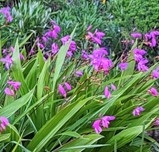UC Gardening Blogs
'Let's Go Mothing' on July 20 at Bohart Museum of Entomology
Let's go mothing! What's mothing? The National Moth Week website describes mothing as "a...

This colorful moth is Arctia virginalis, Ranchman's tiger moth, a diurnal or day-flying moth commonly known as the Ranchman's tiger moth. In its larval stage, it's a wooly bear caterpillar, commonly found at the Bodega Marine Reserve and on the trails of Bodega Head, Sonoma County. (Photo by Kathy Keatley Garvey)

This is California Pyrausta Moth (Pyrausta californicalis), commonly known as "the mint moth." It feeds on plants in the mint family, including spearmint and peppermint. (Photo by Kathy Keatley Garvey)

This is a pterophorid plume moth (family Pterophoridae). The "T-square" shape is classic. (Photo by Kathy Keatley Garvey)

This is a white-lined sphinx moth (Hyles lineata), which flies during the day and night. (Photo by Kathy Keatley Garvey)
Jeff Smith: Busy as a Bee? No, As Industrious as a Lepidopterist
Busy as a bee? No, as industrious as a Lepidopterist. Specifically, as industrious...

Jeff Smith, curator of the Bohart Museum of Entomology's Lepidoptera collection, chats with visitors at an open house. (Photo by Kathy Keatley Garvey)

Legendary Lepidopterists Paul Opler (left) and Robert Michael Pyle, founder of the Xerces Society for Invertebrate Conservation, chat during the international Lepidopterist Society’s 68th annual conference (2019) that included visits to the Bohart Museum. Opler, who died last year, considered the Bohart Museum Lepidoptera collection "The Bold Standard" of Lep collections. (Photo by Kathy Keatley Garvey)
An Explosion of Color-Chinese Ground Orchid
I've seen Chinese Ground Orchids in my garden before but this year they're extra glorious which inspired me to blog about them. Honesty, before I moved into my house which I bought from an Asian gardener I had never seen nor heard of a “ground orchid.” With these last few years of extraordinary rainfall it seems like they have exploded in my garden, much to my delight!
Bletilla striata is a species of flowering plant in the orchid family Orchidaceae. It is native to Korea, Japan, Myanmar, Tibet and China. It is quite often found growing in clumps along grassy slopes with sandy soil.[1] It is a terrestrial orchid (meaning one that grows in the ground) as opposed to epiphytic orchids that live in tree branches and lithophytic orchids that live in the cracks of rocks.[2] To the right is the clump of orchids that emerged in my garden in this early spring.[3]
This easy to care for, hardy orchid was awarded the prestigious Award of Garden Merit by the Royal Horticultural Society. It grows in clumps reaching 12” to 18” in height and 6” to 12” in width, spreading by creeping rhizomes.[4] It's ideal growing conditions include organically rich, medium moisture, loamy well-drained soil in part shade and part sun, (morning sun and afternoon shade.) This particular orchid is considered the hardiest and was the first one cultivated. Amend the soil with well-composted material prior to planting. After that you can limit fertilization to a less potent, balanced fertilizer, applied once a month. Stop fertilizing and watering when the orchid goes dormant. You can resume when you start seeing new growth in the spring. It is also important to deadhead the spent blooms so the energy can be redirected to the roots for the following years flowers.[5]
If you want to transplant this orchid it is best to wait until it's through flowering but before it enters dormancy. During this period the orchid will have leaves but no flowers. If you try transplanting during it's flowering season the flowers will fall off early! It will also need routine pruning every year especially when the leaves die down to the ground. This will make way for new growth in the spring. In my garden they sprung up this month in greater numbers which was my reward for taking care of them during the year.
In summation this hardy orchid is a garden must. They grow in the soil, can remain outdoors year round (as long as the temperature doesn't drop below freezing), have few pest problems, are relatively low maintenance and are beautiful when in bloom! Try it, you'll like it!!
[1] Wikipedia- Bletilla striata
[2] www.sciencedirect.com- Physiological diversity of orchids
[3] All photos were taken by the author from her garden
[4] Definition of a rhizome- a rootlike, often thickened and usually horizontal underground plant stem that produces shoots above and roots below. Rhizomes store food for the plant and transport water and nutrient to other parts of the plant. Also called a creeping root stalk.
[5] Gardening Know How- Hardy Orchid Plants: Growing Hardy Orchids in the Garden
What are exotic and invasive pests?
Exotic and invasive pests threaten California's natural environments, agricultural production,...
Saga of the Spider and the Bee
(Continued from the July 13th Bug Squad) Our resident crab spider, family Thomisidae,...

The resident crab spider nails a honey bee, as another bee continues to forage in the lavender. (Photo by Kathy Keatley Garvey)

A freeloader fly (family Milichiidae, probably genus Desmometopa), invites itself to dinner. No reservations required. (Photo by Kathy Keatley Garvey)

As the resident crab spider eats its prey, another honey bee arrives to forage on the lavender. (Photo by Kathy Keatley Garvey)




